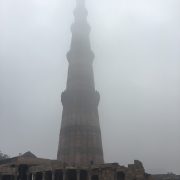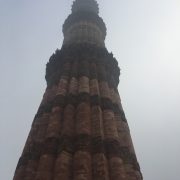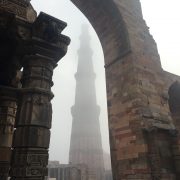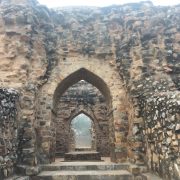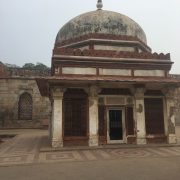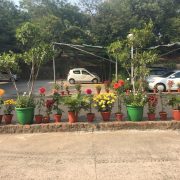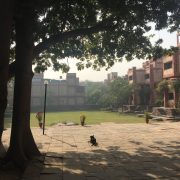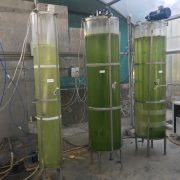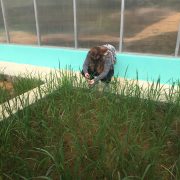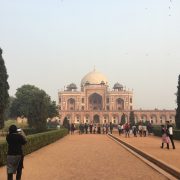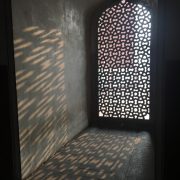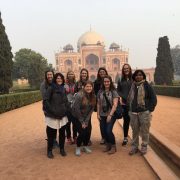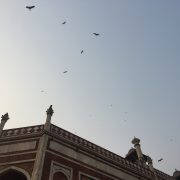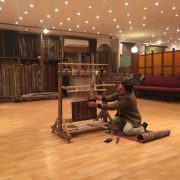l
After arriving in New Delhi late the previous night, our first full day in India was jam packed full of excursions. Starting off very groggy, we went to Kutub Minar. Kutub Minar is the tallest tower made solely of interlocking stone. This means it lacks any sort of metal support. Due to the intense fog that blankets New Delhi every morning, we only received fleeting views of the entirety of the magnificent structure. Over time, different rulers added to the tower resulting defined sections that varied in architecture. (Pictures 1 & 2). There were also ruins of schools, temples, and tombs that sprinkled the land surrounding the tower (Pictures 3,4, & 5). After thoroughly exploring this historical site, we boarded our bus and headed towards the International Center of Genetic Engineering and Biotechnology (ICGEB).
When we arrived at the center, the first thing that caught my eye was just how green the campus. Trees and grass surrounded all of the building, while potted flowers lined the sidewalks (Pictures 6 & 7). Once entering the building, we were guided to a meeting room where were shown a short video that explains what it is that the center does (Video 1). Following this video, we were escorted to a staff lounge where various researchers shared with us what they were doing. The two main research areas that were focused on were malaria and biofuels. First, the malaria research was concerned with better understanding the parasite. Due to its complexity, not all of the protein functions of the parasite are known. They are also testing various plants to see stand to combat the parasite in anyway. Overall, hearing about this research was very interesting because it is not a problem in the United States. I likely would not have heard about such research if I had not traveled in India. Furthermore, it was interesting to learn that Indian pharmaceutical companies are not putting good money into research and development for new drugs. To me, this seems like something they should do since malaria poses such a problem in this developing region of the world. (Video 2). We were also given the opportunity to tour the lab working on this malaria research (Video 3). I was personally blown away by the sheer amount of equipment that this lab possessed. Second, the biofuel research was both in creating a system that produces more enzymes to allow for a greater breakdown of cellulose so tough plants can be made more easily and efficiently into biofuels and in algal biofuels. Of these two areas, we were able to see the lab that was working on the algal biofuels. (Videos 4 &5, and Picture 8). We also got the opportunity to tour various greenhouses, most of which were growing rice (Picture 9 & 10).
After our time at ICGEB, we went to Humayun’s Tomb. Commissioned by his wife following his death, this structure contains the tomb of Humayun, a Mughal Emperor of India. The structure was truly beautiful. (Pictures 11, 12, 13, & 14).
Following our time at Humayun’s tomb, we went to a carpet store. While there, we were given a demonstration on how the carpets were made. It is a very meticulous process of knots done in different colors of thread, usually silk or wool, to produce intricate designs. The carpets were beautiful, and we were encouraged to feel and walk on them (Picture 15).
After the carpet store and to conclude our day, we visited Dilli Haat, a craft bazaar. It was stuffed with stands selling handmade goods from scarfs and shoes to paintings and tiny figurines to metal bangles and earrings. Most of us refrained from buying too many things since it was our first day and knew this was not our only opportunity to buy things. Personally, I was somewhat afraid of having to barter to get a lower price which is a common thing one must do here. There were also bands playing music on traditional instruments in a large pavilion at Dilli Haat. Overall, we had a long, exciting first day in India that set the tone for the remainder of our journey.
- Kutub Minar
- Kutab Minar
- Kutab Minar + surrounding structures
- Kutab Minar + surrounding structures
- Kutab Minar + surrounding structures
- ICGEB
- ICGEB
- Algal biofuel labs
- Rice in greenhouse
- Rice in greenhouse
- Humayun’s Tomb
- Humayun’s Tomb
- Humayun’s Tomb
- Humayun’s Tomb
- Carpet production
